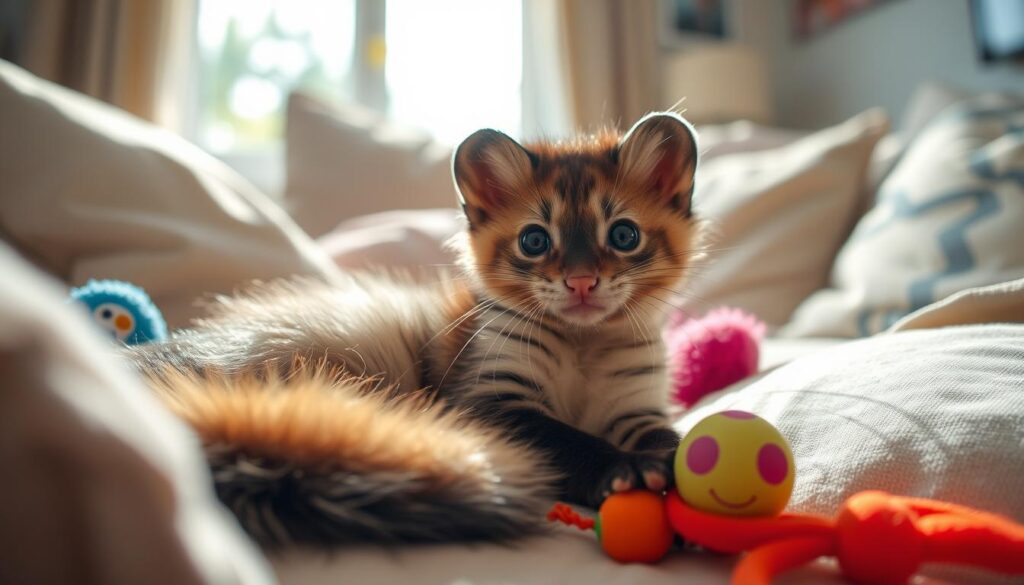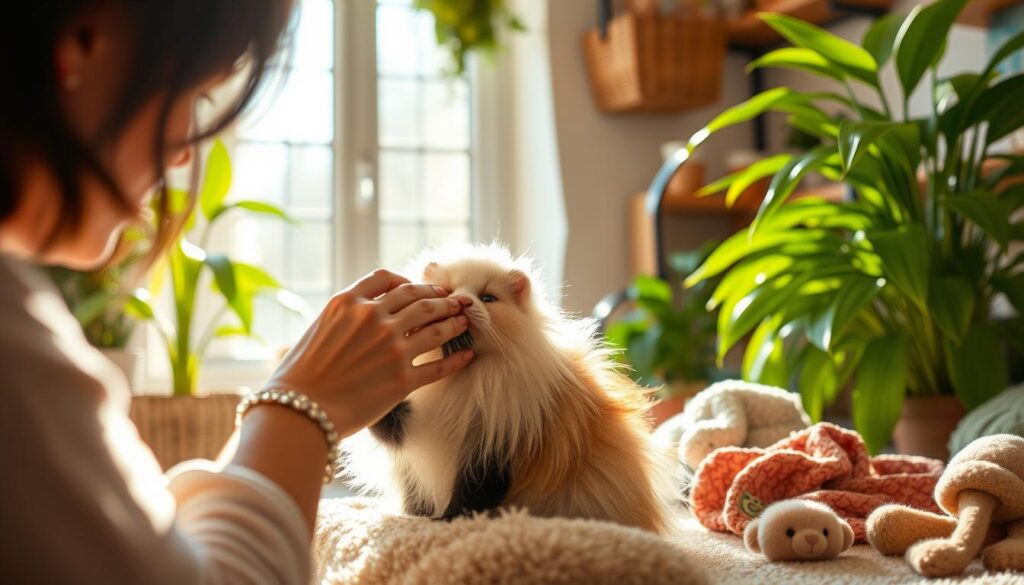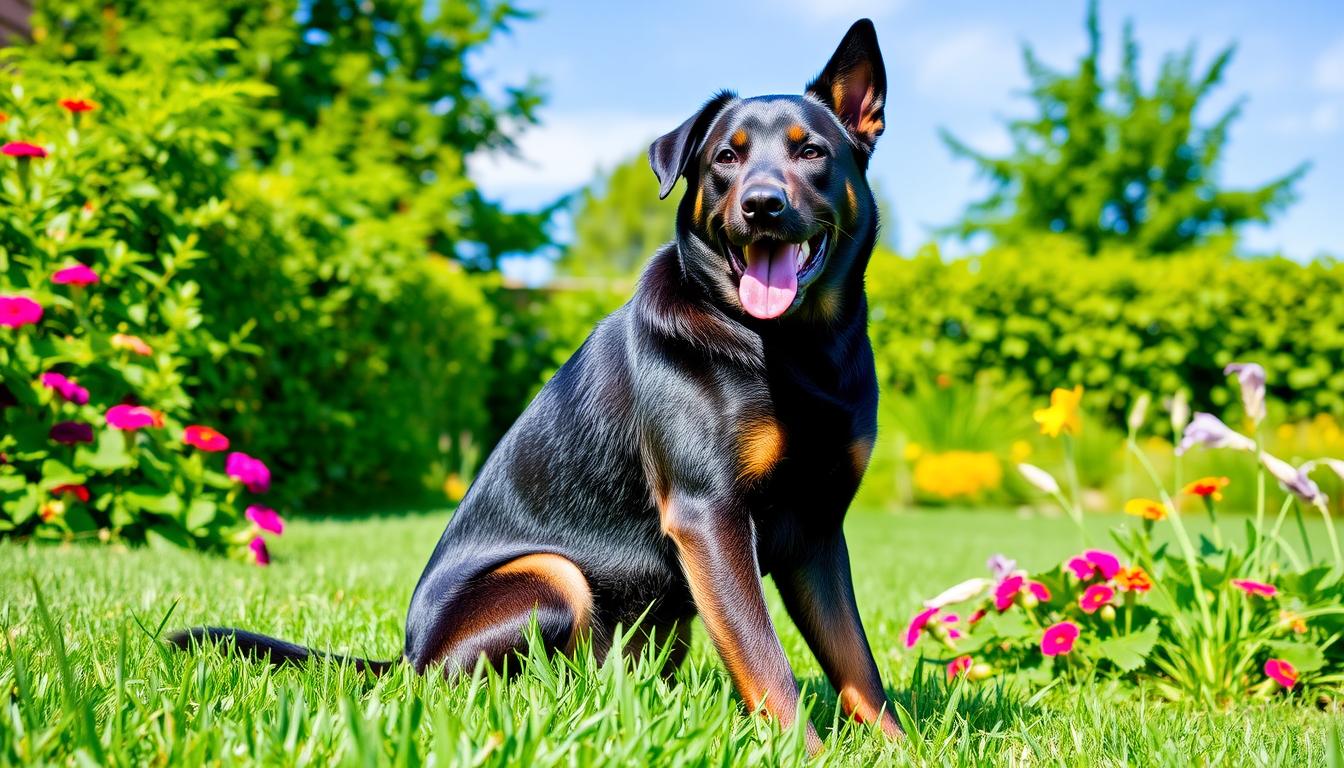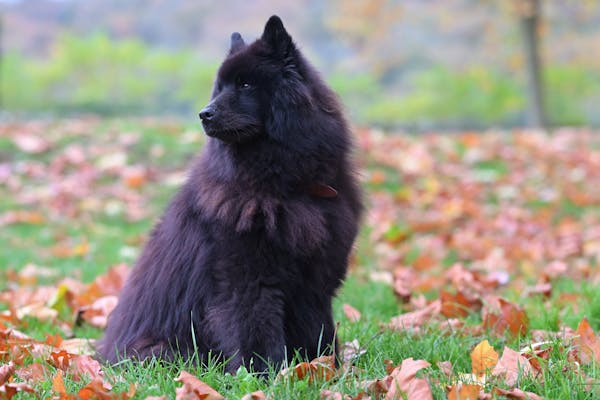Mink Pets: Exotic Companions for Animal Lovers

Did you know that American minks are not in danger, but their European cousins are at risk of disappearing1? Minks are becoming more popular as pets because they are unique and fun. They have their own personality and needs that owners should think about before getting one. Unlike ferrets, minks are bigger, live longer, and have different instincts, making them a special choice for those who love exotic pets1.
For anyone interested in exotic pets, understanding what it means to have a mink as a pet is key.
Key Takeaways
- Minks are unique exotic pets that require specific care and attention.
- American minks are not endangered, but European minks are critically at risk.
- Minks have a carnivorous diet, thriving on a high-protein, low-carbohydrate food.
- With proper care, minks can live up to ten years.
- Strong enclosures are necessary due to their powerful jaws and escape tendencies.
- Legal regulations for mink ownership vary widely across states.
- Minks can be trained, but they require patience and proper reinforcement techniques.
Understanding Exotic Pets
Exotic pets are a unique choice for those looking for something different from the usual dogs and cats. The definition of exotic pets includes animals that are not commonly kept as pets. This group includes a wide variety of species, each needing special care. It’s important for potential owners to understand these needs before bringing one home.
Definition of Exotic Pets
An exotic pet is not a domesticated animal. In the past, it meant wild animals kept in captivity. Now, it also includes animals like reptiles, birds, amphibians, and small mammals kept for companionship. Before getting one, you should think about their care, needs, and the laws about them.
Types of Exotic Pets
There are many types of exotic pets you might want to consider. Here’s a table with some common ones:
| Type of Exotic Pet | Examples | Main Care Considerations |
|---|---|---|
| Reptiles | Snakes, Lizards | Temperature control, diets |
| Birds | Parrots, Finches | Social needs, space |
| Small Mammals | Ferrets, Minks | Diet, companionship |
| Amphibians | Frogs, Salamanders | Moisture, habitat |
Choosing an exotic pet means knowing their unique needs and behaviors. This knowledge makes for a happy life with your new pet. Always check the laws in your area before getting an exotic pet, as they can vary23.
The Allure of Mink Pets
Many people are drawn to mink pets because of their charm. They have a mix of playful behavior, curiosity, and unique traits. This makes them stand out among exotic pets. Knowing what makes minks special can help you see why they’re chosen as pets.
Unique Characteristics of Mink
Minks are known for their sleek bodies and luxurious fur. They are playful and enjoy interacting with people. They are also smart, solving problems and using tools. These unique characteristics of mink make them popular among exotic pet lovers.
Why Choose a Mink as a Pet
Thinking about getting a new pet? Consider a mink. They look striking and love to interact, making them great companions. Their personalities and ability to bond with owners make them rewarding pets. For those looking for a pet that offers fun and companionship, minks are a great choice.
The charm of mink pets comes from their unique traits that set them apart from common pets4.
Mink Pet: An In-Depth Look
To truly appreciate having a mink as a pet, it’s key to know about their physical appearance and behavioral traits. This info helps you care for your new friend better.
Physical Appearance
The American mink looks amazing, with its smooth and shiny fur. It comes in colors like dark blackish-tawny to light-tawny5. They grow up to about 2 feet long, with their tails making up a third of that6.
Men are 13–18 inches long, and women are a bit shorter, 12–15 inches5. Their tails are 6–10 inches long5. In winter, men weigh 1–3 lb and women 1–2 lb5. Their fur in winter is both thick and soft, making them look even more beautiful.
Behavioral Traits
Minks are playful and curious. They love to hunt, eating things like fish, mice, and frogs6. They’re great swimmers, diving up to 16 feet and swimming 35 yards underwater6. This makes them lively, so they need lots of play and social time.
Female minks get ready to have babies at about one year old, and men take a bit longer, around 18 months6. Knowing these things can make owning a mink even more rewarding.
Caring for a Mink

A serene indoor scene featuring a person gently brushing a mink’s soft fur, with vibrant green plants in the background, sunlight streaming through a window, and cozy pet accessories scattered around, conveying a sense of warmth and companionship.
Caring for a mink means knowing what they need. This includes their diet, where they live, and how much they need to interact with others. These things are key to keeping your pet mink happy and healthy.
Dietary Needs of Pet Minks
Pet minks need a special diet. They do well on a diet high in protein, similar to what they eat in the wild. Here are some foods they can have:
- Raw meat (like chicken, rabbit, or beef)
- Fish
- Eggs
- Specialized ferret or mink food
Make sure their food is free from harmful additives. Feed them regularly and always have fresh water available. This keeps them hydrated.
Housing Requirements
It’s important to create a good home for your mink. Their living space should be like their natural habitat. Think about these things when setting up their area:
- Spacious enclosures with room for movement
- Hiding spots and tunnels for enrichment
- Proper ventilation
- Safe bedding material such as straw or soft fabric
Keep their living area clean to stop health problems. Check for any signs of injury or illness often. If you see something wrong, act fast7.
Socialization and Interaction
Minks love to play and be around others. They need regular time with you to stay happy and busy. Playing with them, giving them toys, and letting them explore helps their minds. When you touch or hold your mink, be gentle and let them get used to you slowly. This builds trust and comfort. Watching their health and behavior is key to a good life with you.
Looking after a mink is rewarding if you know what they need. Understanding their diet, living space, and social needs is important. With the right care, your mink will do great in its new home8.
Mink Care Guide
Caring for your mink is important for their health and happiness. It includes routine veterinary care, exercise, and grooming tips. These steps are key for their well-being.
Routine Veterinary Care
Regular vet visits are crucial for minks. They can get diseases like canine distemper, which is deadly. Vaccines like Nobivac DPv or Purevax Ferret Distemper Vaccine help protect them9.
They also need yearly shots for the Enteritis Vaccine. This starts when they are 6-8 weeks old9. It keeps them safe from a contagious disease. Blood tests during vet visits help keep track of their health9. Checking their heart is also important because they can have heart problems9.
Exercise Needs
Minks love to move and need lots of space to do so. They need areas for play and exploration. This keeps them happy and healthy.
Introducing them to water for swimming is great after 6-8 weeks. It’s natural for them and keeps them active10. Playing with your mink is important. They love to explore and be active.
Grooming Tips
Grooming is important for minks. It keeps their fur looking great and helps with hygiene. Brushing them prevents mats and sheds less. It also lets you check for skin problems or parasites.
Make grooming gentle and comfortable for your mink. Some minks don’t like being handled a lot9. Always be kind during grooming.
Potential Challenges of Having a Mink as a Pet

A vivid indoor scene showcasing the mischievous behavior of a mink pet, with scattered toys, knocked-over plants, and a playful yet chaotic atmosphere. The room design features furniture slightly askew, an open drawer with items spilling out, and a curious mink peeking out from behind a couch, capturing the challenge of keeping a mink in a home environment.
Owning a mink can be thrilling, but it has its challenges. You need to think about the legal and financial sides before getting one. This part will talk about the laws and costs of having a mink as a pet.
Legal Considerations
Before getting a mink, learn about your area’s laws on exotic pets. Some places have strict rules that might need permits, while others don’t allow minks at all. Breaking these laws can lead to big fines, so it’s key to do your homework on the legal side of exotic pets11. Knowing the laws can help you avoid legal trouble and make owning a pet smoother.
Cost of Ownership
Having a mink costs a lot and includes many expenses. First, there’s the cost of buying the mink, which can be from a few hundred to thousands of dollars. Then, there are ongoing costs like special food, setting up a habitat, and vet care. Minks might need yearly vet visits and could need emergency care, adding to the cost12. So, it’s important to plan your budget to handle the expenses of having a mink.
| Expense Type | Estimated Cost |
|---|---|
| Initial Purchase | $500 – $2,000 |
| Specialized Food | $20 – $50 per month |
| Habitat Setup | $200 – $800 |
| Veterinary Care | $100 – $500 annually |
Exotic Pet Ownership Regulations
It’s key to know the rules about owning exotic pets. These rules help protect the animals and keep everyone safe. Make sure you understand the state-specific laws for minks and the permits for mink ownership to stay out of trouble.
State-Specific Laws
Rules for exotic pets change a lot from state to state. In Alabama, you don’t need any special permits for exotic animals like lions or monkeys13. But in Alaska, you need a license for certain animals, and no one can have a wolf hybrid bought after a certain date13. Arizona says you need a license for some exotic pets, like monkeys13.
In Arkansas, you can’t own big carnivores, and in California, you can only keep wild animals if you got them before a certain year13. Colorado also limits who can own exotic pets, unless you’re in business13. Connecticut doesn’t allow keeping dangerous animals, and Delaware needs a permit for wild mammals13. Florida limits who can own certain wildlife, and Georgia only lets licensed dealers have dangerous animals13.
Hawaii doesn’t allow exotic pets, and Idaho needs permits for certain exotic animals13. In Illinois, you can only keep dangerous animals in special places, showing how different states have their own rules for minks.
Permits Required for Keeping Minks
Getting a permit for a mink can depend on where you live, so do your homework before getting one. More people are keeping exotic pets, like minks, which worries about health and safety14. There are thousands of big cats and millions of reptiles kept as pets in the U.S., showing how common this is14. It’s important to keep up with changing laws to follow both state and federal rules on exotic pets.
Pros and Cons of Keeping a Mink as a Pet
Thinking about getting a mink as a pet? It’s key to look at both the good and the bad sides. Minks can be great companions, but they do need special care.
Advantages of Mink Companionship
Minks are playful and curious, making them fun to be around. They are smart, which means they can interact with you in interesting ways. Plus, they don’t need much exercise, which is good for busy people.
Their unique behaviors make watching them entertaining. Choosing confident minks can also make their life better and improve their fur quality15.
Disadvantages and Challenges
But, there are downsides to having minks as pets. They need special care, which can be hard. They eat only meat and need to be socialized well to behave well.
They sleep at night, which might not fit everyone’s schedule. Also, picking a brave mink is important for their well-being and breeding15.
| Aspect | Advantages | Disadvantages |
|---|---|---|
| Companionship | Playful and curious nature | Challenges in socialization |
| Exercise Needs | Low requirements | Potential for behavioral issues without stimulation |
| Dietary Requirements | Encourages proper meat-based nutrition | Demanding and specific dietary needs |
| Behavior | Engaging and intelligent | Nocturnal habits may not suit all owners |
In summary, getting a mink as a pet has its pros and cons. Owners should think about both the good and the bad before deciding16.
Finding a Mink for Your Home
Getting a mink can be thrilling, but make sure you do it right. You can either find reputable breeders or look into rescue groups for exotic pets. Each path has its pros and cons, so it’s important to know them before deciding.
Reputable Breeders vs. Rescues
When looking for a mink, you have two main options: reputable breeders and rescue groups. Breeders offer healthy minks from controlled settings, bred for specific traits. They also provide health and care advice to help your pet settle in. Rescue groups, on the other hand, help minks in need of a new home. They let you give a loving home to an animal that’s had a tough past. No matter which path you choose, doing your homework is crucial to find the right mink for your family.
Preparing Your Home for a Mink
Getting your home ready for a mink is key for a smooth start. Start by checking your space to make sure it’s right for your new pet. American minks need enclosures of at least 10×10 feet, with more space for each additional mink3. They also love water, so your enclosure should have a good mix of land and water areas17.
- Make sure there’s safe water in the enclosure that’s at least 1.2 feet deep.
- Add different levels to the enclosure for their active nature.
- Give your mink regular access to a safe, clean outdoor area to keep them happy and busy.
Getting a mink is a big step, but with the right preparation and care, it can be incredibly rewarding. By knowing how to find a mink responsibly and creating a great home for it, you’re setting the stage for a beautiful friendship.
Community and Resources for Mink Owners
Being a mink owner can be rewarding with the right support. Connecting with others who care for these pets offers great advice and insights. It helps with the unique challenges of mink care.
Online Forums and Support Groups
Online forums for exotic pet owners are great for sharing tips and stories. You’ll find discussions on feeding, behavior, and more. It’s a place to ask questions, get help, and meet experienced mink owners.
Books and Publications on Mink Care
Books on mink care are crucial for learning how to keep your pet happy and healthy. They cover the specific needs and behaviors of minks. You can also find resources that recommend trusted books and guides.
These resources build a supportive community and ensure your mink gets the best care. Being part of dedicated groups and reading informative books makes you a better owner. It leads to a strong bond with your pet, based on understanding and care18.
Conclusion
Owning a mink as a pet is a unique experience filled with fascinating traits and behaviors. They stand out with their striking looks and fun personalities. But, it’s crucial to think carefully before bringing one home. You need to understand their needs and the challenges they might bring.
Learning about mink care is key. This includes knowing about their diet, social needs, and where they should live. It’s also important to know the laws and rules about having a mink. This way, you can enjoy the special bond with your exotic pet without worries.
Deciding to get a mink means you’re ready to meet their needs and connect deeply with them. This species offers great rewards but requires a thoughtful choice. Think about the happiness they can bring and the care they need before deciding. For those ready, having a mink as a pet can be a unique experience in pet ownership1920.
FAQ
What makes minks suitable as exotic pets?
Minks are playful and curious, making them great companions. They are smart and social, appealing to those looking for unique pets.
What do minks eat, and how should I care for their diet?
Minks need a diet rich in protein. It’s important to feed them a balanced diet. You can use commercial mink diets or high-quality meats.
How much space do I need to keep a pet mink?
Minks need space to play and explore. They do well in environments that feel like their natural habitat. Providing a secure, enriched area is key for their health.
What are the legal considerations for owning a mink as a pet?
Legal rules for owning minks vary by state. It’s important to check the laws in your area before getting a mink. You might need permits.
Can minks get along with other pets?
Minks have a strong instinct to hunt, which can be a problem with other pets. Watch how they interact with other animals. Think about the temperaments of your other pets before adding a mink.
What kind of veterinary care do minks need?
Regular vet visits are crucial for your mink’s health. Include routine exams, shots, and preventative care in your mink care plan.
Where can I find a reputable breeder or rescue for a pet mink?
Look for reputable breeders or exotic pet rescues to find a mink. Make sure the source of your mink values animal welfare and ethical practices.
What grooming practices should I follow for my mink?
Brushing your mink several times a week is key to keeping their fur looking great. Also, keep them clean to prevent skin problems and matting.
What are the advantages and disadvantages of owning a mink?
Having a mink as a pet offers unique companionship and doesn’t require much exercise. But, they need special care and may have behavioral issues.
Source Links
- Minks as Pets: Discussing the Ethics | PangoVet – https://pangovet.com/pet-lifestyle/general/minks-as-pets/
- All About Pet Mink – Exotic Pet Wonderland – https://exoticpetwonderland.org/2023/12/12/pet-mink/
- Pet Mink Care Guide – Exotic Pet Wonderland – https://exoticpetwonderland.org/exotic-pet-care-guides/pet-mink-care-guide/
- The Beauty and Charm of Dogs Without Fur – https://medium.com/@dogloverscore/the-beauty-and-charm-of-dogs-without-fur-72f4f3c89803
- American mink – https://en.wikipedia.org/wiki/American_mink
- The Mighty Mink: Cool Things You Should Know – https://www.iowadnr.gov/About-DNR/DNR-News-Releases/ArticleID/522/The-Mighty-Mink-Cool-Things-You-Should-Know
- Mink – Operation Wildlife – https://owl-online.org/animal-guide/mink/
- Mink – https://www.esf.edu/aec/adks/mammals/mink.php
- Mink Care – https://mustelid-madness.myshopify.com/pages/mink-care
- Microsoft Word – Orphan Mink Care_2020 NWRA – https://cdn.ymaws.com/www.nwrawildlife.org/resource/resmgr/symp_2020/saturday_handouts/Popp_Mustelids_Sat_Orphan_Mi.pdf
- Neovison vison (American mink) – https://animaldiversity.org/accounts/Neovison_vison/
- The Secret Life of American Mink • Nebraskaland Magazine – https://magazine.outdoornebraska.gov/2024/03/the-secret-life-of-american-mink/
- State Laws: Private Possession of Exotic Animals | Born Free USA – https://www.bornfreeusa.org/campaigns/animals-in-captivity/summary-state-laws-exotic-animals/
- Exotic Pet Laws | Animal Legal & Historical Center – https://www.animallaw.info/intro/exotic-pet-laws
- Breeding confident mink can have side benefits – https://www.sciencedaily.com/releases/2015/12/151208134118.htm
- Animal Energy – American Mink – https://www.wildspeak.com/animalenergies/americanmink.html
- Mink Care & Basic Info | Saveafox – https://www.saveafox.org/mink-care-sheet
- Helping animals helps us all. – https://www.animalwellnessfoundation.org/
- Mink | Description, Habitat, Conservation Status, & Facts – https://www.britannica.com/animal/mink
- Meet “Mork” the Mink – http://



